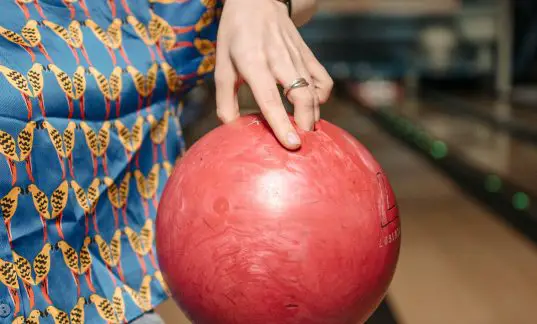Bowling balls are fickle friends. Sometimes a ball hits the pocket in a way that looks like a guaranteed strike, only to leave a split. And sometimes you add more ball speed only to watch your ball veer off towards the gutters near the end of your shot.
Often, it takes a balance of the ideal ball speed, smart entry angle positioning, and the right bowling lane to find your sweet spot on the pin deck. In hopes of aiding you in this process, we’ve created this guide to help you with the first factor in that equation — bowling speed.
Does a slower shot mean fewer strikes? Will speed control help you dominate at local bowling centers? What perils does a fast bowler face that a slower bowler does not?
Let’s dive deep into bowling speeds and how they affect everything from how a ball impacts the pins to the way you should put together your ball swing.
Does ball speed matter in bowling?
It does, but maybe not in the way that most bowlers think. In short, you shouldn’t be calculating ball speed just to throw as fast and hard as you can. That’s often a dangerous methodology that can lead to arm burnout, decreased pin carry, and lower scores as your bowling night goes along.
Most pro bowlers don’t head to the foul line looking to torch the pins with breakneck speeds. Most professionals release the ball at 20-22 miles per hour with pin impact speeds around 17 miles per hour or so. That’s lower than some league bowlers! But, the effective speed of such a calibrated throw helps them optimize pin action and their rev rate numbers.
More speed is harder to control. Less speed is harder to make booming impacts. Finding the optimal speed for your throwing technique is an important factor in finding scoring bliss when you play.
What is the average speed range for a bowling ball?
The average speed of a thrown bowling ball is tricky to calculate. A young child will throw slow because they don’t have the weight or power behind them to throw faster. And some bowlers will throw as hard as they can just to show they can, regardless of whether or not they hit the head pin straight on and cause themselves split headaches.
The average speed range for a bowling ball varies from around 8 miles per hour to 20 miles per hour of effective speed — the speed calculation that averages your release speed and your impact speed. And if you use a lighter ball, oftentimes your ball speed will be faster than someone of a similar build throwing a 15 or 16-pound bowling ball.
What is the ideal bowling ball speed?
If you’re looking for bowling tips to find your ideal bowling ball speed, you first need to look at your throwing technique. As we said before, the ideal bowling ball speed for a pro bowler is usually around 17 to 18 miles per hour — all key factors considered.
As you might expect, your ball travels differently than that of a professional bowler. And your game plan will likely need to be different based on many factors involved with your shot.
Finding your ideal bowling ball speed depends on what you need. Do you need quicker releases and higher rev rates? Do you need a slower, steadier hook? What works best for you?
Calibrate your ball speed to find your best results. It’s the only way to find your groove and it takes practice.
Does your average bowling ball speed change when a bowling ball hooks?
It can. A bowling ball hook takes energy, and oftentimes that energy will decrease your overall bowling ball speeds. And depending on the complexity and depth of a particular oil pattern, you might have to alter your ball speed to adequately shape your particular hook shot.
In addition, faster hooks are much harder to control and slot into the pin pocket when you bowl. If you’re trying to work with a sharp entry angle, decreasing your speed just a bit might help if you keep hitting to the left or right of your intended target.
How do you increase ball speed?
Ball manufacturers have gone to great lengths to make balls faster and more angular. Sometimes, just finding the right equipment will help to increase your MPH tolerance and effectiveness at higher speeds.
Otherwise, optimizing your throwing technique and approach is the way to go. The smarter you are about footwork and swing mechanics, the better you’ll be at getting your ball speed where you need it.
How do lane conditions affect your average ball speed?
When bowling lanes are extremely slick, you might need to decrease your average bowling ball speed to compensate. That’s because it’s harder to control your ball through the heads and off the break point when the oil gets deep.
It’s not a catch-all rule of thumb, but you might want to calibrate your speed higher or lower based on the overall oil density of a given lane.
Frequently Asked Questions
How does a bowling alley go about calculating bowling ball speed?
Most modern bowling alleys are equipped with sensors that monitor the ball as it travels down the lane, giving bowlers the average miles per hour of a given throw. These sensors take into account the elapsed time of a throw and the actual speed of a ball to calculate a number for easy cataloging.
What is the best bowling ball speed for an experienced bowler?
As we said before, it depends on everything from lane conditions to the three key factors of your particular throw (technique, hook, ball weight). Most pro bowlers have an average ball speed of around 17 to 18 miles per hour. However, your average speed will vary based on your circumstances
Does a fast ball speed mean more strikes?
Not necessarily. More ball speed is great when you hit the pocket just right. But, higher ball speeds make it harder to control a throw — especially on slick and complex oil patterns. If you’re struggling to knock down much of anything with your fastest throw, pull back a bit and focus on accuracy. By dropping your speed anywhere from 0.5 to 3 miles per hour, you might increase your pin carry!
What is the fastest recorded bowling ball speed?
The fastest recorded bowling ball speed in history is 161.3 kilometers per hour (100.2 mph), recorded by Pakistan’s Shoaib Akhtar back in 2003. Akhtar broke the previous record of 160.6 kilometers per hour (99.8 mph), set by Australia’s Jeffrey Thomson back in 1975.
Since Akhtar’s record-setting throw, two more players have passed Thomson on the list directly behind him — Australia’s Shaun Tait (100.1 mph) and Australia’s Brett Lee (99.9 mph).
Will a bowling ball speed chart help me find the best ball speed for me?
It’s not brain surgery. The more information you have about your throwing technique and optimal ball speed, the better chances you’ll have at scoring big during a bowling game. However, the average speeds listed on a bowling ball speed chart don’t take into account your particular nuances as a play. Use the chart as a guide, but tailor your throw to your own needs and wants as a player.
Closing Thoughts
In conclusion, bowling well is about more than throwing hard. Your bowling speed can only take you so far if your technique is off or you’re not using the right equipment. It’s better to find an ideal ball speed than it is to wear out your arm, and it’s smarter to release the ball with the mindset of optimizing your particular talents as a player.

